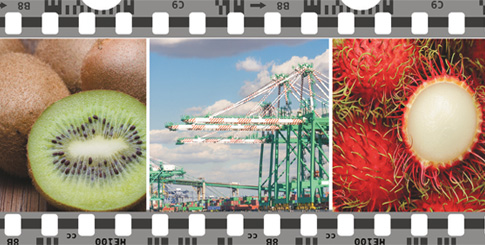While Los Angeles may be most famous as the heart of the film and television industry, the produce trade has played a strong supporting role throughout the city’s storied history.
Long before its epic entertainment industry was born, the City of Angels was revered as an agricultural powerhouse. As a companion piece to this year’s Los Angeles market spotlight, we take a look back at L.A.’s fresh produce past.
Our timeline begins in the 1800s, many years before Napa and Sonoma were labeled as California’s wine country, when Los Angeles was home to the Golden State’s first vineyard.
For four decades, from 1909 to 1949, Los Angeles was the most productive agricultural county in the United States. During this era, farmers throughout the region harvested everything from grapes, oranges, and berries to cauliflower, celery, and tomatoes.
A Tale of Two Ports
Since the early 1900s, two L.A.-area ports have served as a major hub for California’s produce industry, moving millions of pounds of fruit and vegetables each year.
Officially founded in 1907, the Port of Los Angeles is located in San Pedro Bay, 25 miles south of downtown. The Port spans 7,500 acres of land and water along 43 miles of waterfront, and has the capacity to handle billions of dollars’ worth of cargo each year.
“The Port of Los Angeles is a megalopolis, with 21 million consumers within 200 miles of the port,” explains Phillip Sanfield, director of media relations for the Port of Los Angeles. The Port also benefits from an ideal location, only 20 miles from the Los Angeles Wholesale Produce Market.
In 1911, just a few years after the Port of LA was founded, the City of Long Beach opened its own port. Today, nearly 70 million pounds of fresh produce moves through the Port of Long Beach each year—mostly grapes, apples, pears, plums, peaches, avocados, and kiwi from Chile.
“As America’s second-busiest container port, the Port of Long Beach provides the capacity for easy, efficient access to the western United States and especially the sizable Los Angeles regional population,” remarks Dr. Noel Hacegaba, chief commercial and operations officer with the Port of Long Beach.
The two ports have always been competitors, but joined forces when necessary over the decades. “While Long Beach and Los Angeles compete for business,” confirms Hacegaba, “the two ports have cooperated on major regional infrastructure projects including the Intermodal Container Transfer Facility, a major railyard operated by Union Pacific, and the Alameda Corridor rail freight expressway connecting the two ports to transcontinental railyards near downtown Los Angeles.”



